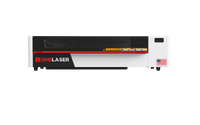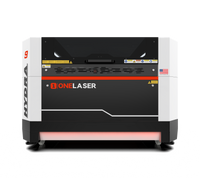Thinking about buying a laser engraver but not sure where to start? You’re not alone. With dozens of models, power options, and price points, it’s easy to get overwhelmed—or worse, buy the wrong machine and outgrow it in months.
Key Takeaway
This guide distills the essentials from OneLaser’s buyer education clips into a clear, practical roadmap. You’ll learn what to look for when buying a laser engraver, how to compare desktop vs. cabinet systems, hobby vs. professional machines, and where to buy a laser engraver with confidence.
Whether you’re a first-time buyer, upgrading an older CO₂ unit, or turning a side hustle into a business, use this playbook to choose a machine that fits your projects, space, and budget—without costly mistakes.
1. The Growing Popularity of Laser Engraving
Laser engraving has seen an explosion in popularity over the past decade.
According to present analytical results of industry expert, with the growth of Laser Engraving Machine market, growth of the global laser processing market is expected to reach more US$ 15 Bn by 2022 due to rising demand for high quality and authentic end-products.

The search trend for “laser engraving” in the United States over the past five years shows a consistent level of interest with noticeable seasonal peaks.
Demand tends to rise sharply during the holiday seasons (Q4), which aligns with increased consumer activity around personalized gifts and custom products.
Significant spikes can be seen in late 2023 and late 2024, suggesting growing popularity and awareness of laser engraving.
Despite natural fluctuations, the overall trend remains stable and healthy, indicating that this is a reliable niche with steady year-round demand, boosted by seasonal opportunities.

2. Start With Your Use Case (Project > Machine > Budget)
Before you compare specs, clarify what you’ll actually make and where you’ll do it. Ask yourself:
- What do I produce? Small gifts, tumblers, plaques, signage, furniture inlays, batch orders
- What materials? Wood, acrylic, leather, paper, coated metals? (CO₂ shines here.)
- What size and thickness? Determines bed size, tube type, and airflow needs.
- How fast do I need to deliver? Speed and reliability = real money if you sell.
- How much room do I have? Desktop vs. cabinet footprint matters.
- Which laser accessories do I need day one? Rotary, riser base, air assist, camera, conveyor feeder.
Mapping this first keeps you from overspending on features you won’t use—or under sizing the machine you’ll outgrow.
3. Desktop vs. Cabinet: Pick the Form Factor That Fits Your Life
When choosing a laser engraver, your workspace and workload point you toward one of two families:
3.1 Desktop CO₂ - OneLaser X Series: XRF, XT
Best for: Small spaces, beginners, Etsy shops, gift makers.
Pros: Compact footprint; lower entry cost; professional CO₂ quality (leagues beyond cheap diodes); upgrade paths like riser base (more Z-height) and rotary (tumblers, mugs).
Typical uses: Personalized gifts, tags, ornaments, acrylic jewelry, photo engravings, logos on coated metals.
Explore the OneLaser X Series!

3.2 Cabinet CO₂ - OneLaser Hydra Series
Best for: Shops with space, growing businesses, classrooms, and light industrial work.
Pros: Larger work area, motorized bed for tall stock, more power options, and true production speed/reliability. Hydra offers glass CO₂ tubes (strong cutting) or RF metal tubes (razor-sharp engraving).
Typical uses: Signage, multi-piece panels, furniture parts, batching high volumes, mixed-material builds.

Rule of thumb: If space and budget are tight and your projects are small to medium, start desktop. If you’re selling at volume, need larger parts, or want a “buy once, cry once” platform, go cabinet.
4. Hobby vs. Professional: Why “Cheap” Often Costs More
You’ll see ultra-low-cost hobby lasers (often diodes) beside professional CO₂ machines. Here’s the real tradeoff:
- Hobby (mostly diode): Lower upfront cost, limited cutting capability, slower jobs, frequent tinkering. Fine for learning or light craft use—but unreliable if you sell products.
- Professional CO₂: High speed (up to 1200 mm/s in OneLaser’s lineup), consistent quality, less downtime, and a path to scale. This is what you want if deadlines and profit matter.
If you’re asking “should I buy a laser engraver?” for a business, the answer is yes—as long as it’s a professional CO₂ unit that won’t bottleneck your orders.
5. What to Look For When Buying a Laser Engraver (Feature Checklist)
Now that you're seriously considering buying a laser engraver, what exactly should you be looking for? It’s important to prioritize certain features to ensure you get the best return on your investment.
5.1 Power Options:
- Glass CO₂ tube: Excellent cutting power on wood/acrylic; great all-rounder for makers.
- RF metal tube: Costlier, but ultra-precise engraving, fine text, tight corners, instant firing.
- Wattage: Higher watts = faster cuts on thicker stock. Match watts to typical materials and thickness.

5.2 Ease of Use:
Beginners, in particular, will want to prioritize machines that are user-friendly. For instance, the OneLaser machine comes equipped with OneTouch™ screen controls, which make the engraving process simple and intuitive.
If you're new to laser engraving, ease of use can significantly reduce your learning curve and help you get projects started quickly.

5.3 Safety Features:
Safety is always a critical consideration when working with laser machinery. The OneLaser machine comes with FumeGuard™, which filters out harmful fumes, making it safe for use in smaller home studios or workshops.
In addition, many models include safety features like automatic shut-off or protective casing to shield users from laser exposure.

5.4 Motion, Speed & Accuracy
Look for high engraving speeds with solid acceleration and stable motion control. Smooth, fast motion shortens cycle times without wobble or banding.

5.5 Bed Size & Z-Height
Fit your largest design plus jigs/fixtures. Motorized Z helps with thick stock and pass-through workflows.
5.6 Air Assist (Critically Important)
- Air assist for cutting: Keeps edges clean, reduces char/flame, protects lenses.
- Dual-mode air (low for engraving, high for cutting): Cleaner engravings and safer, faster cuts.
- Bonus if air can be toggled per layer in LightBurn.
5.7 Optics & Lenses
Quality mirrors/lenses matter. Quick-swap lenses help you move between fine engraving and deep cutting.
5.8 Camera & Alignment
On-board camera aids placement, nesting, and contour alignment—huge time-saver for printed/odd-shape parts.
5.9 Upgrade Path & Ecosystem
Rotary, riser, conveyor feeder, air assist modules—ensure the machine supports the add-ons you’ll need as you grow.
5.10 Software and Connectivity:
Advanced laser engravers often come with proprietary software that enhances the engraving process. Look for machines that are compatible with a wide range of design software, such as LightBurn, Adobe Illustrator or CorelDRAW, so you can work with your preferred tools.
Additionally, connectivity options like Wi-Fi or USB make transferring designs more seamless. Some machines even offer cloud-based software, allowing you to manage projects remotely.

5.11 Warranty and Support:
When investing in a laser engraver, especially as a beginner, having access to good customer support and a comprehensive warranty is crucial. You'll want to make sure that spare parts, technical support, and troubleshooting assistance are easily accessible. Manufacturers like OneLaser provide excellent after-sales service, which ensures you won't be left in the dark if any issues arise with your machine.
If you’re wondering "where can I buy a laser engraver" that ticks all these boxes, looking into specialized vendors like OneLaser is a good place to start.
Explore the OneLaser X Series!
6. Budget vs. Value: Why the “Right” Laser Pays You Back
It’s tempting to buy the cheapest machine you can find. But a buyer-smart approach considers total value:
- Time is money: Faster engraving and fewer re-cuts = more jobs per day.
- Consistency = reputation: Pro machines deliver repeatable quality that builds five-star reviews.
- Less downtime: Reliable hardware and strong support keep you shipping.
- Longevity: Solid frames, quality rails, and proven tubes cut your long-term cost per part.
If you’re comparing two machines, ask: Which one makes me more revenue per hour over the next 12–24 months? That’s the one to buy.
7. Potential Revenue Streams: Can You Make Money with a Laser Engraver?
One of the main reasons people ask "should I buy a laser engraver?" is the potential for profit. The answer depends on your market and how you plan to use the machine.
The demand for customized and personalized items is booming, with customers willing to pay premium prices for unique products.
Popular products that you can create with a laser engraver include:
Personalized Gifts:
Laser-engraved gifts for weddings, birthdays, and anniversaries are highly popular. Items like custom wine glasses, engraved photo frames, and personalized jewelry boxes are just a few examples.
Machines like the OneLaser X Series can handle these projects with ease, thanks to its large workspace and precision engraving.

Business Branding:
Laser engraving offers a unique way for businesses to brand products. You can create custom signage, branded promotional products, or even engrave logos on metal, wood, or plastic.
With a machine like the XRF model, which excels at detailed 3D photorealistic engravings, you can offer high-end, professional-grade branding services.
Home Décor:
Laser engraving is a popular choice for creating intricate home décor items. From personalized wall art to custom furniture engravings, the creative possibilities are endless.
The OneLaser XT model’s ability to handle various materials makes it an ideal choice for projects that require both versatility and precision.
8. Buying a Laser Engraver: Avoid These Five Common Mistakes
- Chasing the lowest price instead of total value and support.
- Under-sizing the bed—then turning down profitable big jobs later.
- Ignoring air assist—it’s essential for safe, clean air assist laser cutting.
- Skipping filtration when working indoors (health and compliance matter).
- Not planning accessories (rotary/riser/camera) that your product line actually demands.
Let's Hear from Our Community!
9. Where to Buy a Laser Engraver and Cutter With Confidence
If you’re wondering where can I buy a laser engraver or where can I buy a laser cutter, start with reputable, laser-focused manufacturers and dealers who:
- Publish real specs and demonstrate real jobs.
- Offer financing options for individuals and businesses.
- Provide US-based engineers or responsive support you can actually reach.
- Have a clear warranty and parts pipeline.
- Can advise you on X Series vs. Hydra style decisions (desktop vs. cabinet, glass vs. RF).
10. FAQs
Q: Should I buy a laser engraver if I’m new?
A: Yes—if you choose a professional CO₂ unit with good support. Start with a desktop CO₂ and grow into a cabinet as orders increase.
Q: What to look for when buying a laser engraver?
A: Fit (bed and Z height), tube type/power, motion speed/accuracy, air assist, software compatibility (LightBurn), camera alignment, filtration, upgrade path, and strong warranty/support.
Q: Where to buy a laser engraver?
A: From reputable manufacturers/dealers that specialize in lasers, offer real support, and can configure desktop laser engraver (X Series) or cabinet (Hydra) systems for your needs.
Q: Where can I buy a laser cutter for signage and thicker acrylic?
A: Look for a cabinet CO₂ laser engraver with a larger work area and higher wattage glass tube, compressor air assist, and a motorized bed—plus camera for alignment and batching.
Conclusion
So, is buying a laser engraver the right investment for you? It depends on your goals, market demand, and willingness to invest in quality equipment.
If you're asking "where to buy a laser engraver", ensure you select a machine that meets your needs and offers a strong return on investment. Look for features that make operation smooth, like safety systems, fast engraving speeds, and future-proof capabilities.
Whether you plan to start a small business or expand your existing product offerings, buying a laser engraver could be the key to unlocking new revenue streams and creative possibilities. Just be sure to do your research and invest in a machine that aligns with your business goals.

 Liquid error (sections/image-banner line 171): invalid url input
Liquid error (sections/image-banner line 171): invalid url input






